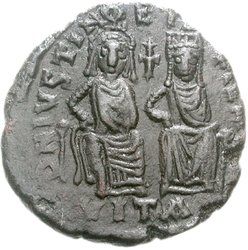Sophia (Byzantium)
Aelia Sophia ( Middle Greek Αἴλια Σοφία ; * around 530; † after 601) was the wife of the Eastern Roman emperor Justin II (565-578).
Life
According to the church history of John of Ephesus , Sophia was a niece of Theodora I. During Justinian's reign , she married his nephew Justin. The couple had at least two children, a son Justus and a daughter Arabia.
Since the year 565 empress, Sophia was represented as the first Augusta on coins with the same insignia as the imperial consort. From the very beginning she had a great influence on Justin's personnel and financial policy. When the emperor showed signs of serious mental illness in the course of the failures in the Persian War from the end of 573 onwards , Sophia took over the business of government. She managed to negotiate a three-year armistice with Chosrau I. In order to secure her internal position of power, she let the emperor raise the comes excubitorum and successful general Tiberius Constantinus to Caesar and co-regent in a “clear phase” on December 7, 574 . Sophia is said to have pursued further marriage plans, but Tiberios refused to separate from his wife Ino Anastasia .
After Justin's death and Tiberios' accession to the throne on October 5, 578, Sophia was deposed as regent , but kept the title of Augusta and an apartment in the palace. Because she did not want to come to terms with the loss of power, she took part in a court intrigue with the aim of replacing Tiberios with Justinian , the younger brother of the murdered general Justin , according to Gregor von Tours . The plot was uncovered, but this had no serious consequences for Sophia.
Even during the reign of Tiberios' successor Maurikios , she continued to reside in her imperial apartments in Constantinople . The last time Sophia was mentioned in connection with Easter celebrations was in Hagia Sophia in 601. It is unclear whether she survived the fall of Maurikios and the massacres ordered by Phocas the following year.
literature
- Averil Cameron : The Empress Sophia. In: Byzantion. Vol. 45, 1975, ISSN 0378-2506 , pp. 5-21.
- Lynda Garland: Byzantine Empresses. Women and power in Byzantium, AD 527-1204 . Routledge, London / New York 1999, pp. 40–58, ISBN 0-415-14688-7 ( full text in the Google book search).
- Anne L. McClanan: Representations of Early Byzantine Empresses. Image and Empire. Palgrave, New York 2002, ISBN 0-312-29492-1 , pp. 149-178.
Web links
- Lynda Garland: Short biography (English) at De Imperatoribus Romanis (with references).
| personal data | |
|---|---|
| SURNAME | Sophia |
| ALTERNATIVE NAMES | Aelia Sophia (full name); Αίλια Σοφία (Middle Greek) |
| BRIEF DESCRIPTION | Wife of the Eastern Roman Emperor Justin II (565-578) |
| DATE OF BIRTH | around 530 |
| DATE OF DEATH | after 601 |
